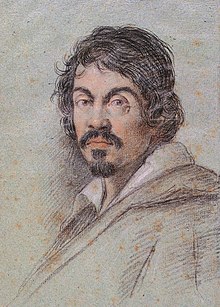
Michelangel Merisi, best known for his town of origin, Caravaggio, east of Milano.
http://besidetheeasel.blogspot.com/2012/10/caravaggio.html
Caravaggio's Wikipedia Entry
http://en.wikipedia.org/wiki/Caravaggio

Caravaggio's Wikipedia Entry
http://en.wikipedia.org/wiki/Caravaggio
He burst upon the Rome art scene in 1600 with the success of his first public commissions, the Martyrdom of Saint Matthew and Calling of Saint Matthew. Thereafter he never lacked commissions or patrons, yet he handled his success poorly. He was jailed on several occasions, vandalized his own apartment, and ultimately had a death warrant issued for him by the Pope.[5]
An early published notice on him, dating from 1604 and describing his lifestyle three years previously, recounts that "after a fortnight's work he will swagger about for a month or two with a sword at his side and a servant following him, from one ball-court to the next, ever ready to engage in a fight or an argument, so that it is most awkward to get along with him."[6] In 1606 he killed a young man in a brawl and fled from Rome with a price on his head. He was involved in a brawl in Malta in 1608, and another in Naples in 1609, possibly a deliberate attempt on his life by unidentified enemies. This encounter left him severely injured. A year later, at the age of 38, he died under mysterious circumstances in Porto Ercole in Tuscany, reportedly from a fever while on his way to Rome to receive a pardon...
Caravaggio led a tumultuous life. He was notorious for brawling, even in a time and place when such behavior was commonplace, and the transcripts of his police records and trial proceedings fill several pages. On 29 May 1606, he killed, possibly unintentionally, a young man named Ranuccio Tomassoni from Terni (Umbria). The circumstances of the brawl and the death of Ranuccio Tomassoni remain mysterious. Several contemporary avvisi referred to a quarrel over a gambling debt and a tennis game, and this explanation has become established in the popular imagination.[24] But recent scholarship has made it clear that more was involved. Good modern accounts are to be found in Peter Robb's "M" and Helen Langdon's "Caravaggio: A Life". An interesting theory relating the death to Renaissance notions of honour and symbolic wounding has been advanced by art historian Andrew Graham-Dixon.[25] Previously his high-placed patrons had protected him from the consequences of his escapades, but this time they could do nothing. Caravaggio, outlawed, fled to Naples. There, outside the jurisdiction of the Roman authorities and protected by the Colonna family, the most famous painter in Rome became the most famous in Naples. His connections with the Colonnas led to a stream of important church commissions, including the Madonna of the Rosary, and The Seven Works of Mercy.[26]
Some scholars argue that Caravaggio was murdered by the same "enemies" that had been pursuing him since he fled Malta, possibly Wignacourt and/or factions in the Order of St. John.[36] Caravaggio might have died of lead poisoning. Bones with high lead levels were recently found in a grave likely to be Caravaggio's.[37] Paints used at the time contained high amounts of lead salts. Caravaggio is known to have indulged in violent behavior, as caused by lead poisoning.
Caravaggio never married and had no known children, and Howard Hibbard notes the absence of erotic female figures from the artist's oeuvre: "In his entire career he did not paint a single female nude."[38] On the other hand, the cabinet-pieces from the Del Monte period are replete with "full-lipped, languorous boys ... who seem to solicit the onlooker with their offers of fruit, wine, flowers - and themselves."[39] Nevertheless, a connection with a certain Lena is mentioned in a 1605 court deposition by Pasqualone, where she is described as "Michelangelo's girl".[40] According to G.B.Passeri this 'Lena' was Caravaggio's model for theMadonna di Loreto. According to Catherine Puglisi 'Lena' may have been the same as the courtesan Maddalena di Paolo Antognetti, who named Caravaggio as an intimate friend by her own testimony in 1604.[41][42] Caravaggio also probably enjoyed close relationships with other "whores and courtesans" such as Fillide Melandroni, of whom he painted a portrait.[43]

No comments:
Post a Comment